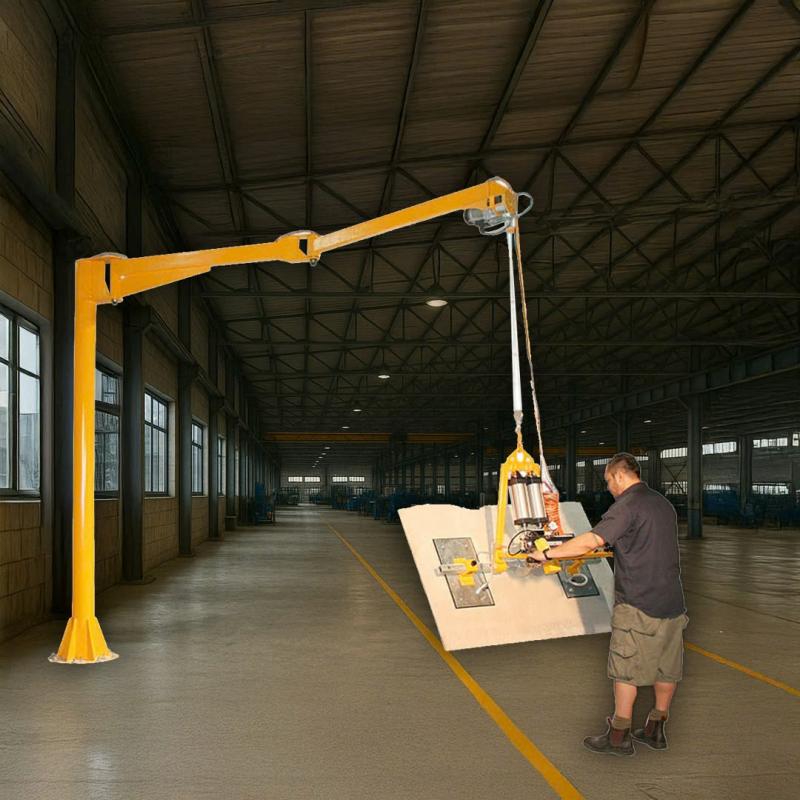



Among the myriad of options available, Jib Cranes have emerged as a versatile and efficient solution for various material handling needs. This article delves into the advantages of jib cranes compared to other lifting systems, helping you determine the best fit for your operational requirements.
Jib Cranes are a type of crane where a horizontal member (jib or boom), supporting a moveable hoist, is fixed to a wall or to a floor-mounted pillar. They are commonly used in industrial settings for repetitive lifting tasks within a fixed radius.
Freestanding Jib Crane: Mounted on the floor and supported by a vertical mast, offering 360-degree rotation and ideal for open areas.
Wall Mounted Jib Crane: Attached to a wall or column, providing 180-degree rotation, suitable for workstations with limited floor space.
Ceiling Mounted Jib Crane: Suspended from the ceiling, freeing up floor space and allowing for 360-degree rotation.
Articulating Jib Crane: Features a two-part arm, enabling movement around obstructions and into hard-to-reach areas.
Pillar Jib Crane: Similar to freestanding cranes but with a fixed pillar, offering robust support for heavy loads.
For a comprehensive overview of current trends in crane technology, refer to Cranes Trends.
Overhead Cranes are typically used for heavy-duty lifting across large areas, such as in manufacturing plants or warehouses. They consist of parallel runways with a traveling bridge spanning the gap.
Comparison:
Installation: Jib cranes are easier and less costly to install, especially in existing facilities.
Space Utilization: Jib cranes require less structural support and can be installed in confined spaces.
Cost: Generally, jib cranes are more cost-effective for localized lifting tasks.
For an in-depth comparison, see Jib Crane Comparisons.
Gantry Cranes are similar to overhead cranes but are supported by freestanding legs that move on wheels or along a track.
Comparison:
Mobility: Gantry cranes offer mobility across a workspace, whereas jib cranes are fixed.
Load Capacity: Gantry cranes typically handle heavier loads.
Space Requirements: Jib cranes are more space-efficient, ideal for smaller work areas.
Davit Arms are small cranes used for light lifting tasks, often in marine applications.
Comparison:
Load Capacity: Jib cranes can handle heavier loads.
Versatility: Jib cranes offer greater range of motion and adaptability.
Applications: Davit arms are limited to specific tasks, while jib cranes are suitable for various industrial applications.
Versatility: Suitable for various applications, from workshops to warehouses.
Space Efficiency: Ideal for confined spaces due to their compact design.
Ease of Use: Simple operation with minimal training required.
Cost-Effective: Lower installation and maintenance costs compared to larger crane systems.
Customization: Available in various configurations to meet specific needs.
For insights into the future developments of industrial jib cranes, visit Industrial Jib Cranes Future.
When considering the installation of a jib crane, it's essential to assess your specific operational requirements, including load capacity, reach, and rotation. Proper installation ensures safety and maximizes efficiency.
For a step-by-step guide on installing a jib crane, refer to apply a jib crane.
Articulated Jib Cranes are designed with a two-part arm, allowing for increased flexibility and movement around obstacles. They are ideal for complex work environments where standard jib cranes may not suffice.
Explore more about articulated jib cranes at To Explore Articulated Jib Cranes.
Wall-Mounted Jib Cranes are perfect for facilities with limited floor space. They are mounted directly to a wall or column, providing efficient lifting capabilities without occupying valuable floor area.
Discover solutions for wall-mounted jib cranes in your warehouse at Wall-mounted Jib Cranes in your warehouse.
Selecting the right lifting system is pivotal for operational efficiency. Jib Cranes offer a versatile, cost-effective, and space-efficient solution for various industrial applications. By understanding the specific advantages of jib cranes over other systems, businesses can make informed decisions that enhance productivity and safety.
For more information on the latest trends and developments in crane technology, visit Cranes Trends.
References
1. How to operate a Jib Cranes safely
3. Over brace jib crane wall mounted
5. Is a Jib Crane a Gantry Crane
6. Articulated Jib Crane Wall Mounted
8. Manual Counterbalance Crane
10. Over Braced Jib Crane Column Mounted
Sign up to receive the latest info on new Aardwolf products, special offers and more.
By signing up you agree to receive emails from Aardwolf with news, special offers, promotions and other information. You can unsubscribe at any time.